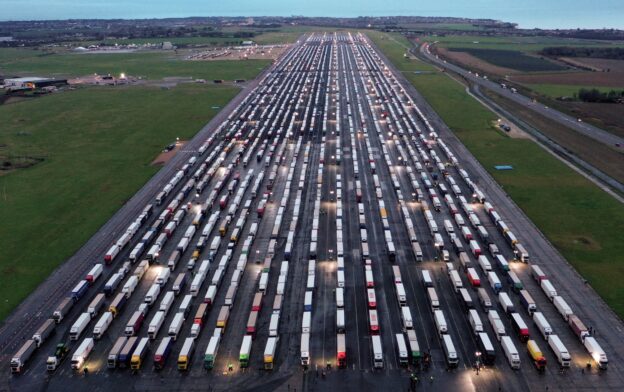- Waymo is leading the U.S. autonomous vehicle market, expanding its robotaxi fleet and services, while GM’s Cruise program is restarting after a high-profile setback.
- Federal rule changes now allow for faster AV deployment and reduced reporting requirements, sparking both optimism and safety concerns.
- Projections show U.S. AV sales rising slowly through 2034, while China’s market is expected to grow rapidly, highlighting global competition in autonomous mobility.

After several successful pilot projects, several cities across the United States are aiming to roll out more self-driving vehicles in 2025. Multiple automated car companies have announced new projects for this year. For decades, self-driving or automated vehicles (AVs) seemed like some futuristic technology that would be impossible to actually create. However, in recent years, several companies have tested their AVs in real-life conditions, as several car models make it out of the factory and onto our roads. In addition, recent innovations in sensors and artificial intelligence (AI) have made researchers more enthusiastic about what the future of automation might hold.
There are five levels of automation, from vehicles with driver assistance to fully automated vehicles that do not require a human driver. In 2024, several ride-hailing companies incorporated AVs into their fleets as companies fixed the glitches that had been experienced in trials in previous years. The self-driving startup Waymo is currently the U.S. market leader in AVs, while several traditional automakers, such as General Motors (GM), play catch up. While progress has been slower than previously anticipated, largely owing to delays caused by the Covid-19 pandemic, greater AV adoption is expected for 2025.
As AV sales grow slowly, the outlook for self-driving vehicles looks positive. U.S. AV sales are expected to reach around 230,000 autonomous mobility-as-a-service units a year by 2034, to contribute just under a 1.5 percent market share. In China, the market is expected to grow more rapidly to reach 1.5 million AVs being sold annually by 2034. Meanwhile, in Europe, sales are expected to reach just 37,000 units by 2034.
Market leader Waymo unveiled the sixth generation of its Waymo Driver autonomous driving system in 2024. The company operates a fleet of almost 800 self-driving vehicles in California, as well as another fleet in Phoenix. Last year, Waymo’s parent company Alphabet announced plans to invest up to $5 billion in the startup. Earlier in 2024, Waymo commenced the testing phase of its robotaxi services on highways in San Francisco, fitted with its fifth-generation system. It also partnered with the electric vehicle company Zeekr to test a robotaxi on public roads in San Francisco in July 2024.
In May this year, Waymo was approved to expand its autonomous ride-hailing service to more parts of the San Francisco Bay Area. The company had submitted a request to the California Public Utilities Commission in March to access a broader area. San Jose Mayor Matt Mahan stated, “Waymo embodies our region’s spirit of innovation – so it’s about time they joined us here in the Capital of Silicon Valley,” in a post on social media.
In April, Alphabet announced that Waymo is now providing more than 250,000 paid robotaxi rides per week across the U.S. That same month, Waymo and Toyota announced a preliminary partnership, with the aim of incorporating robotaxi tech into personally-owned vehicles.
Meanwhile, GM, which was on track to compete with Waymo, experienced a setback in October 2023 when one of its AVs was involved as a secondary vehicle in a pedestrian accident. GM halted its Cruise Automation programme for several months while it assessed its safety standards and changed much of the department’s leadership. Cruise has resumed operations as well as announced plans to launch its robotaxis on the Uber ride-hailing platform starting this year.
In terms of the broader rollout of AVs across the U.S., the Secretary of Transportation Sean Duffy announced in April that the department had revised the AV rulebook to allow for faster deployment of self-driving cars. Duffy stated, “America is in the middle of an innovation race with China, and the stakes couldn’t be higher.” The new rules reduce the crash data that companies are required to send to regulators and focus on ensuring that U.S.-built robotaxis can compete with those from foreign firms.
The revision aims to trim “unnecessary burdens” on companies and reduce expenses while maintaining “safety benefits.” In addition, certain compliance measures will be waived for domestic vehicles under the new rules, to allow for testing on public streets, which could fast-track Tesla’s Cybercab and similar robotaxis. However, critics suggest reducing an engineer’s paperwork can result in a blind spot for analysts, which could prevent researchers from spotting patterns in AV driving. “Transparency and accountability about the performance of these vehicles on public roadways is essential,” explained the president of Advocates for Highway and Auto Safety Cathy Chase.
After a setback during the Covid-19 pandemic, several automakers are now on track to launch AV models with various levels of automation in cities across the U.S. Recent improvements in technology and a change in federal AV rules are expected to increase the rollout of AVs in 2025. Several companies are partnering with ride-hailing platforms to offer their AVs on restricted routes and, if successful, we could be seeing a lot more self-driving cars on the roads in the coming years.
https://oilprice.com/Energy/Energy-General/The-Autonomous-Vehicle-Race-Has-Well-and-Truly-Begun.amp.html





